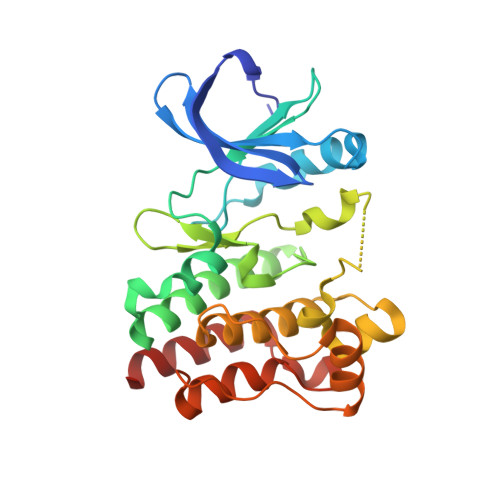Utilizing structure based drug design and metabolic soft spot identification to optimize the in vitro potency and in vivo pharmacokinetic properties leading to the discovery of novel reversible Bruton's tyrosine kinase inhibitors.
Hopkins, B.T., Bame, E., Bell, N., Bohnert, T., Bowden-Verhoek, J.K., Bui, M., Cancilla, M.T., Conlon, P., Cullen, P., Erlanson, D.A., Fan, J., Fuchs-Knotts, T., Hansen, S., Heumann, S., Jenkins, T.J., Gua, C., Liu, Y., Liu, Y., Lulla, M., Marcotte, D., Marx, I., McDowell, B., Mertsching, E., Negrou, E., Romanowski, M.J., Scott, D., Silvian, L., Yang, W., Zhong, M.(2021) Bioorg Med Chem 44: 116275-116275
- PubMed: 34314938
- DOI: https://doi.org/10.1016/j.bmc.2021.116275
- Primary Citation of Related Structures:
7N4Q, 7N4R, 7N4S - PubMed Abstract:
Bruton's tyrosine kinase (BTK) is an essential node on the BCR signaling in B cells, which are clinically validated to play a critical role in B-cell lymphomas and various auto-immune diseases such as Multiple Sclerosis (MS), Pemphigus, and rheumatoid arthritis (RA). Although non-selective irreversible BTK inhibitors have been approved for oncology, due to the emergence of drug resistance in B-cell lymphoma associated with covalent inhibitor, there an unmet medical need to identify reversible, selective, potent BTK inhibitor as viable therapeutics for patients. Herein, we describe the identification of Hits and subsequence optimization to improve the physicochemical properties, potency and kinome selectivity leading to the discovery of a novel class of BTK inhibitors. Utilizing Met ID and structure base design inhibitors were synthesized with increased in vivo metabolic stability and oral exposure in rodents suitable for advancing to lead optimization.
Organizational Affiliation:
Biogen Inc., 225 Binney Street, Cambridge, MA 02142, USA. Electronic address: Brian.Hopkins@biogen.com.















